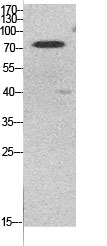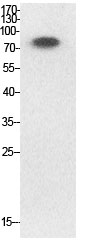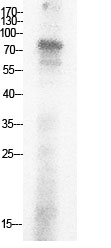
Catalog: YK0048
Size
Price
Status
Qty.
200μL
$600.00
In stock
0
100μL
$340.00
In stock
0
50μL
$190.00
In stock
0
Add to cart


Collected


Collect
Main Information
Target
Ubiquitin
Host Species
Rabbit
Reactivity
Human, Mouse, Rat
Applications
WB, IHC, IF, ELISA
Conjugate/Modification
Acetyl
Detailed Information
Recommended Dilution Ratio
WB 1:500-1:2000; IHC: 1:100-300; ELISA 1:20000; IF 1:50-200
Formulation
Liquid in PBS containing 50% glycerol, 0.5% BSA and 0.02% sodium azide.
Specificity
Acetyl-Ub (K27) Polyclonal AntibodySynthesized peptide derived from the human Ub around the acetylation site of K27.The name of modified sites may be influenced by many factors, such as species (the modified site was not originally found in human samples) and the change of protein sequence (the previous protein sequence is incomplete, and the protein sequence may be prolonged with the development of protein sequencing technology). When naming, we will use the "numbers" in historical reference to keep the sites consistent with the reports. The antibody binds to the following modification sequence (lowercase letters are modification sites):NVkAK
Purification
The antibody was affinity-purified from rabbit antiserum by affinity-chromatography using epitope-specific immunogen.
Storage
-15°C to -25°C/1 year(Do not lower than -25°C)
Concentration
1 mg/ml
Modification
Acetyl
Clonality
Polyclonal
Isotype
IgG
Related Products
Antigen&Target Information
Immunogen:
Synthesized acetyl-peptide derived from the human Ub around the acetylation site of K27.
show all
Specificity:
Acetyl-Ub (K27) Polyclonal AntibodySynthesized peptide derived from the human Ub around the acetylation site of K27.The name of modified sites may be influenced by many factors, such as species (the modified site was not originally found in human samples) and the change of protein sequence (the previous protein sequence is incomplete, and the protein sequence may be prolonged with the development of protein sequencing technology). When naming, we will use the "numbers" in historical reference to keep the sites consistent with the reports. The antibody binds to the following modification sequence (lowercase letters are modification sites):NVkAK
show all
Gene Name:
UBA52/RPS27A/UBB/UBC
show all
Protein Name:
Ubiquitin
show all
Other Name:
UBB ;
Polyubiquitin-B ;
UBC ;
Polyubiquitin-C ;
RPS27A ;
UBA80 ;
UBCEP1 ;
Ubiquitin-40S ribosomal protein S27a ;
Ubiquitin carboxyl extension protein 80 ;
UBA52 ;
UBCEP2 ;
Ubiquitin-60S ribosomal protein L40 ;
CEP52 ;
Ubiquitin A-52 residue ribosomal protein fusion product 1
Polyubiquitin-B ;
UBC ;
Polyubiquitin-C ;
RPS27A ;
UBA80 ;
UBCEP1 ;
Ubiquitin-40S ribosomal protein S27a ;
Ubiquitin carboxyl extension protein 80 ;
UBA52 ;
UBCEP2 ;
Ubiquitin-60S ribosomal protein L40 ;
CEP52 ;
Ubiquitin A-52 residue ribosomal protein fusion product 1
show all
Background:
Ubiquitin is a highly conserved nuclear and cytoplasmic protein that has a major role in targeting cellular proteins for degradation by the 26S proteosome. It is also involved in the maintenance of chromatin structure, the regulation of gene expression, and the stress response. Ubiquitin is synthesized as a precursor protein consisting of either polyubiquitin chains or a single ubiquitin moiety fused to an unrelated protein. This gene encodes a fusion protein consisting of ubiquitin at the N terminus and ribosomal protein L40 at the C terminus, a C-terminal extension protein (CEP). Multiple processed pseudogenes derived from this gene are present in the genome. [provided by RefSeq, Jul 2008],
show all
Function:
Function:Protein modifier which can be covalently attached to target lysines either as a monomer or as a lysine-linked polymer. Attachment to proteins as a Lys-48-linked polymer usually leads to their degradation by proteasome. Attachment to proteins as a monomer or as an alternatively linked polymer does not lead to proteasomal degradation and may be required for numerous functions, including maintenance of chromatin structure, regulation of gene expression, stress response, ribosome biogenesis and DNA repair.,miscellaneous:This ribosomal protein is synthesized as a C-terminal extension protein (CEP) of ubiquitin.,miscellaneous:Ubiquitin is synthesized as a polyubiquitin precursor with exact head to tail repeats, the number of repeats differ between species and strains. In some species there is a final amino-acid after the last repeat, here in human a Val. Some ubiquitin genes contain a single copy of ubiquitin fused to a ribosomal protein (either L40 or S27a).,PTM:Several types of polymeric chains can be formed, depending on the lysine used for the assembly.,similarity:Belongs to the ribosomal protein L40e family.,similarity:Belongs to the ribosomal protein S27Ae family.,similarity:Belongs to the ubiquitin family.,
show all
Cellular Localization:
[Ubiquitin]: Cytoplasm . Nucleus .; [60S ribosomal protein L40]: Cytoplasm .
show all
Tissue Expression:
Brain,Epithelium,Fetal brain cortex,Liver,L
show all
Research Areas:
>>Ribosome ;
>>Ubiquitin mediated proteolysis ;
>>Mitophagy - animal ;
>>Parkinson disease ;
>>Pathways of neurodegeneration - multiple diseases ;
>>Shigellosis ;
>>Kaposi sarcoma-associated herpesvirus infection ;
>>Coronavirus disease - COVID-19
>>Ubiquitin mediated proteolysis ;
>>Mitophagy - animal ;
>>Parkinson disease ;
>>Pathways of neurodegeneration - multiple diseases ;
>>Shigellosis ;
>>Kaposi sarcoma-associated herpesvirus infection ;
>>Coronavirus disease - COVID-19
show all
Signaling Pathway
Cellular Processes >> Transport and catabolism >> Autophagy - animal
Cellular Processes >> Transport and catabolism >> Mitophagy - animal
Human Diseases >> Neurodegenerative disease >> Parkinson disease
Human Diseases >> Neurodegenerative disease >> Pathways of neurodegeneration - multiple diseases
Genetic Information Processing >> Folding, sorting and degradation >> Ubiquitin mediated proteolysis
Reference Citation({{totalcount}})
Catalog: YK0048
Size
Price
Status
Qty.
200μL
$600.00
In stock
0
100μL
$340.00
In stock
0
50μL
$190.00
In stock
0
Add to cart


Collected


Collect
Recently Viewed Products
Clear allPRODUCTS
CUSTOMIZED
ABOUT US
Toggle night Mode
{{pinfoXq.title || ''}}
Catalog: {{pinfoXq.catalog || ''}}
Filter:
All
{{item.name}}
{{pinfo.title}}
-{{pinfo.catalog}}
Main Information
Target
{{pinfo.target}}
Reactivity
{{pinfo.react}}
Applications
{{pinfo.applicat}}
Conjugate/Modification
{{pinfo.coupling}}/{{pinfo.modific}}
MW (kDa)
{{pinfo.mwcalc}}
Host Species
{{pinfo.hostspec}}
Isotype
{{pinfo.isotype}}
Product {{index}}/{{pcount}}
Prev
Next
{{pvTitle}}
Scroll wheel zooms the picture
{{pvDescr}}











.jpg)







